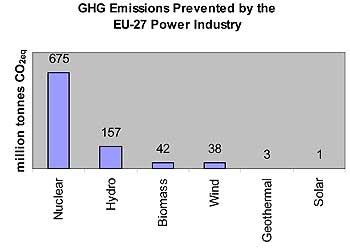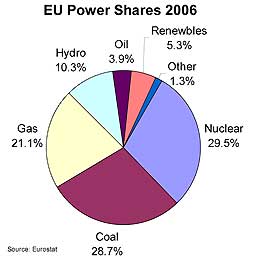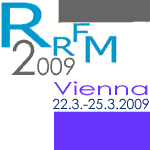

Nuclear Energy and Greenhouse Gas Emissions Avoidance
in the European Union 2008
Every year our friends from FORATOM put together
a detailed report on the latest situation with regards to greenhouse
gas emission avoidance in the EU. This year’s report was
compiled, as always, by Hans Korteweg of FORATOM, and is accompanied
by the latest FORATOM position paper on nuclear energy’s
contribution to the EU’s Post-Kyoto climate change policy.
For further information please contact Hans Korteweg of FORATOM
at: 00 32 2 505 32 24; hans.korteweg@foratom.org 1. Introduction
Climate change, resulting from
increases in greenhouse gas emissions (GHG), is considered
one of the biggest environmental dangers facing the world today.
Reducing atmospheric GHG concentrations have become an international
priority as evidenced by the signing of the Kyoto Protocol.
Electricity
is a clean energy carrier, but to a large extent coal, oil
and gas are burned to produce it. In the future, the emphasis
in
the power generation sector will have to be on cleaner production
methods, such as wind, solar, biomass, hydro and nuclear.
This change in emphasis will be needed to meet future electricity
demand in a way that is low on GHG emissions and compatible
with sustainable development objectives.
Nuclear power is the
single
most significant means of limiting the increase in GHG
concentrations in the power generation sector, while enabling
access to
abundant
electricity at a stable and low cost.
2. Life Cycle GHG Emissions
Nuclear power, unlike fossil fuel, does not
generate GHG directly. For nuclear power and renewable fuels,
there are no GHG emissions at the point of generation, but there
are releases during the mining and processing of the fuel, construction
of the plant, disposal of spent fuel and by-products, and waste
management and decommissioning (see Section 3). The emissions
from these stages depend, among other factors, on the national
mix of electric power production. For example, the GHG emissions
from a nuclear fuel cycle are due to the fossil fuel-based energy
and electricity needed to mine and process fuel and for the construction
and materials of fuel cycle facilities.
The total GHG emissions
from electricity production chains vary widely due to the plant
characteristics (i.e. type, capacity factor, efficiency, and
lifetime) and geographical sitting of the power plant. Recently
published studies (see Appendix I) by International Atomic Energy
Agency (IAEA), the World Energy Council (WEC) and the OECD’s
International Energy Agency (IEA) estimate that on a life cycle
basis the emissions intensity of nuclear power is between 2 and
59 tonnes (expressed as tonnes of CO2-equivalent)
per GWh of electricity produced (t CO2eq/GWh).
For example, according to
a study by the International Atomic Energy Agency (IAEA) in
2000 [1], nuclear energy GHG emissions from the full energy chain
(see Appendix I) amount to only about 9-21 tonnes of GHG (expressed
as tonnes of CO2-equivalent) per GWh of electricity produced
(t CO2eq/GWh), compared to some 385 to 1343 t CO2eq/GWh for
fossil
fuel chains and 9-279 t CO2eq/GWh for renewable energy chains.
3. Factors Influencing GHG Emission Rates from
Nuclear Power (light-water reactor) [1]:
-
Energy use for fuel extraction, conversion, enrichment
and construction / decommissioning (plus materials);
-
Fuel
enrichment by gas diffusion, which is an energy intensive
process that can increase GHG releases by an order of
magnitude when
compared to enrichment by centrifuge;
-
Emissions from
the enrichment step, which are highly country-specific
since they depend on the local fuel mix; and
-
Fuel reprocessing
(uranium
oxide or mixed oxide), which can account for
10% to 15%
of
the total nuclear GHG burden.
4. Updated Calculation for Annual Avoidance
A calculation has been carried out by FORATOM using the range
of total GHG emissions from fossil fuel electricity production
chains calculated by the IAEA [1], the IEA [2] and WEC [3] and
the latest available electricity generation figures from Eurostat
[4].
The following values have been used to estimate
CO2eq emissions
from the use of fossil fuels for electricity generation. The
figures used are at the middle-to-lower end of the range (see
Appendix I).
Coal: 960 (g/kWh or tonnes/GWh)
Oil: 720 (g/kWh or tonnes/GWh)
Gas: 480 (g/kWh or tonnes/GWh) |
We can assume, in a hypothetical scenario, in which the EU’s
146 nuclear reactors are removed from the current (2006) energy
mix and the individual contributions from all other sources are
increased by the
|
same factor (1.49), with
the exception of hydropower, to make up for the loss of
production and to reach a total generation figure of 3,357,958
GWh. It is assumed that
it is unlikely that there could be a significant increase
in hydropower capacity in the EU. Two further assumptions
are made: zero emissions from other non-fossil sources,
such as renewables and nuclear; and no weighting in favour
of gas and wind to take into account of a possible increase
greater than the factor given above.
|
The outcome is a rise in total CO2eq emissions
from 1,365 million tonnes to 2,040 million tonnes, the difference
being just over
675 million tonnes CO2eq. GHG emissions from electricity generation
would rise by 49% if there was no nuclear contribution.
To put the figure of 675 million tonnes into
perspective, it can be pointed out that the annual amount of
CO2eq avoided by nuclear is equivalent to nearly
all the CO2eq emitted each year by the 212.5 million
passenger cars currently
in use on the EU’s roads (728 million tonnes).

Source: Emissions avoided in 2006 calculated using fossil fuel-emission
rates from the IEA, IAEA and WEC and plant generation data from
Eurostat.
The overall Kyoto GHG emission reduction
target of the EU is approximately 446 million tonnes CO2eq.
5. Conclusion
Nuclear energy makes a significant contribution
to the lowering of carbon emissions from the energy sector in
the EU and worldwide. The current use of nuclear energy (accounting
for about 15% of the world’s electricity generation) avoids
the emission of about 2.1 billion tonnes of CO2eq every year. In the EU as whole, the avoidance levels amount to
675 million
tonnes of CO2eq per year, taking into account the current (2006)
energy mix. By comparison, the EU has a GHG emission reduction
target of 446 million tonnes of CO2eq below 1990
level by 2008-2012. To make savings equivalent to those from
the use of nuclear power,
all passenger cars in the EU (212.5 million) would have to be
taken off the roads. Switching to less carbon intensive or low
carbon fuels such as gas, nuclear and renewables will play a
major role in reducing emissions.
|








